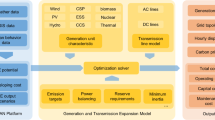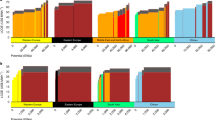Abstract
Inefficient transmission and distribution (T&D) infrastructure that results in losses as electricity travels from supplier to customer contributes to compensatory power generation and therefore to unanticipated GHG emissions. Pilferage, poor planning and management in the T&D system also contribute to losses that can increase total electricity generation. Because the combination of electricity generation, combined heat and power generation and heat plants account for over 40% of global GHG emissions1, mitigation efforts tend to focus on electricity generated rather than delivered. We combine life cycle assessments of power generation with uncertainty analysis to bound potential emissions from compensatory generation from T&D aggregate losses (that is, technical and non-technical) in 142 countries. We estimate that electricity generated due to losses from T&D infrastructure is associated with nearly 1 billion metric tons of carbon dioxide equivalents per year (GtCO2e yr–1). Our global average estimates for potential emissions reductions that may be achieved by improvements in technical losses and aggregate losses are 411 and 544 million metric tons of carbon dioxide equivalents per year (MtCO2e yr–1), respectively. By reducing T&D losses, not only may compensatory emissions be reduced, but more electricity from low-carbon power-plant investments may reach the intended consumers.
This is a preview of subscription content, access via your institution
Access options
Access Nature and 54 other Nature Portfolio journals
Get Nature+, our best-value online-access subscription
$29.99 / 30 days
cancel any time
Subscribe to this journal
Receive 12 print issues and online access
$209.00 per year
only $17.42 per issue
Buy this article
- Purchase on Springer Link
- Instant access to full article PDF
Prices may be subject to local taxes which are calculated during checkout




Similar content being viewed by others
Data availability
The data supporting the findings of this study are available within the article and its supplementary information files. All remaining data are publicly available by the referenced source and available from the corresponding author on reasonable request.
Change history
29 June 2021
A Correction to this paper has been published: https://doi.org/10.1038/s41558-021-01091-w
References
CO 2 Emissions from Fuel Combustion 2018 edn (IEA, 2018).
Pacala, S. & Socolow, R. Stabilization wedges: solving the climate problem for the next 50 years with current technologies. Science 305, 968–972 (2004).
Hertwich, E. G. et al. Integrated life-cycle assessment of electricity-supply scenarios confirms global environmental benefit of low-carbon technologies. Proc. Natl Acad. Sci. USA 112, 6277–6282 (2015).
Kneifel, J. Life-cycle carbon and cost analysis of energy efficiency measures in new commercial buildings. Energy Buildings 42, 333–340 (2010).
Jackson, R. et al. Opportunities for Energy Efficiency Improvements in the U.S. Electricity Transmission and Distribution System (Oak Ridge National Laboratory, 2015).
Reducing Technical and Non-Technical Losses in the Power Sector (World Bank, 2009).
Smith, T. B. Electricity theft: a comparative analysis. Energy Policy 32, 2067–2076 (2004).
IEA Electricity Information Statistics (OECD iLibrary, 2018); https://www.oecd-ilibrary.org/energy/data/iea-electricity-information-statistics_elect-data-en
Intended Nationally Determined Contributions (INDCs); Mitigation Content Database (World Bank, accessed 16 March 2019); http://spappssecext.worldbank.org/sites/indc/Pages/mitigation.aspx
Weisser, D. A guide to life-cycle greenhouse gas (GHG) emissions from electric supply technologies. Energy 32, 1543–1559 (2007).
Lombardi, L. Life cycle assessment comparison of technical solutions for CO2 emissions reduction in power generation. Energy Convers. Manage. 44, 93–108 (2003).
Whitaker, M., Heath, G. A., O’Donoughue, P. & Vorum, M. Life cycle greenhouse gas emissions of coal-fired electricity generation. J. Ind. Ecol. 16, S53–S72 (2012).
O’Donoughue, P. R., Heath, G. A., Dolan, S. L. & Vorum, M. Life cycle greenhouse gas emissions of electricity generated from conventionally produced natural gas. J. Ind. Ecol. 18, 125–144 (2014).
Kasumu, A. S., Li, V., Coleman, J. W., Liendo, J. & Jordaan, S. M. Country-level life cycle assessment of greenhouse gas emissions from liquefied natural gas trade for electricity generation. Environ. Sci. Technol. 52, 1735–1746 (2018).
Turconi, R., Simonsen, C. G., Byriel, I. P. & Astrup, T. Life cycle assessment of the Danish electricity distribution network. Int. J. Life Cycle Ass. 19, 100–108 (2014).
Jorge, R. S. & Hertwich, E. G. Grid infrastructure for renewable power in Europe: the environmental cost. Energy 69, 760–768 (2014).
Arvesen, A., Hauan, I. B., Bolsoy, B. M. & Hertwich, E. G. Life cycle assessment of transport of electricity via different voltage levels: a case study for Nord-Trøndelag county in Norway. Appl. Energy 157, 144–151 (2015).
Masanet, E. et al. Life-cycle assessment of electric power systems. Annu. Rev. Env. Resour. 38, 107–136 (2013).
Pehl, M. et al. Understanding future emissions from low-carbon power systems by integration of life-cycle assessment and integrated energy modelling. Nat. Energy 2, 939 (2017).
Hsu, D. D. et al. Life cycle greenhouse gas emissions of crystalline silicon photovoltaic electricity generation: systematic review and harmonization. J. Ind. Ecol. 16, S122–S135 (2012).
Kim, H. C., Fthenakis, V., Choi, J.-K. & Turney, D. E. Life cycle greenhouse gas emissions of thin-film photovoltaic electricity generation:systematic review and harmonization. J. Ind. Ecol. 16, S110–S121 (2012).
Dolan, S. L. & Heath, G. A. Life cycle greenhouse gas emissions of utility-scale wind power. J. Ind. Ecol. 16, S136–S154 (2012).
Warner, E. S. & Heath, G. A. Life cycle greenhouse gas emissions of nuclear electricity generation. J. Ind. Ecol. 16, S73–S92 (2012).
Coleman, J. W., Kasumu, A., Liendo, J., Li, V. & Jordaan, S. M. Calibrating Liquefied Natural Gas Export Life Cycle Assessment: Accounting for Legal Boundaries and Post-export Markets Occasional Paper No. 49 (Canadian Institute of Resources Law, 2015).
Burkhardt, J. J., Heath, G. & Cohen, E. Life cycle greenhouse gas emissions of trough and tower concentrating solar power electricity generation. J. Ind. Ecol. 16, S93–S109 (2012).
Life Cycle Assessment Harmonization (National Renewable Energy Laboratory, accessed 18 November 2018); https://www.nrel.gov/analysis/life-cycle-assessment.html
World Energy Outlook 2017; International Energy Agency (OECD iLibrary, 2017); https://www.oecd-ilibrary.org/energy/world-energy-outlook-2017_weo-2017-en
Jiménez, R., Serebrisky, T. & Mercado, J. Sizing Electricity Losses in Transmission and Distribution Systems in Latin America and the Caribbean (Inter-American Development Bank, 2014).
Fragile States Index 2016 (The Fund for Peace, 2016); http://fundforpeace.org/wp-content/uploads/2018/08/fragilestatesindex-2016.pdf
Comoros—Electricity Sector Recovery Project (English) (World Bank, 2013).
Upadhyay, A. & Singh, R. K. How One Woman Tried to Stop a $10 Billion Theft (BloombergNEF, 2017); https://about.bnef.com/blog/how-one-woman-tried-to-stop-a-10-billion-theft/
Quadrennial Energy Review: Energy Transmission, Storage, and Distribution Infrastructure (US Department of Energy, 2015); https://go.nature.com/2YpGR0S
Tracking Clean Energy Progress (International Energy Agency, accessed 20 August 2018); http://www.iea.org/tcep/
World Energy Investment 2018 (IEA, 2018); https://www.iea.org/wei2018/.
Grid Modernization Initiative (US Department of Energy, accessed 18 November 2018); https://www.energy.gov/grid-modernization-initiative
National Smart Grid Mission (NSGM) (Government of India, Ministry of Power, accessed 18 November 2018); http://www.nsgm.gov.in/en/nsgm
MIT Energy Initiative. The Future of the Electric Grid (Massachusetts Institute of Technology, 2011).
Chicco, G. & Mancarella, P. Distributed multi-generation: a comprehensive view. Renew. Sustain. Energy Rev. 13, 535–551 (2009).
Jorge, R. S., Hawkins, T. R. & Hertwich, E. G. Life cycle assessment of electricity transmission and distribution—part 1: power lines and cables. Int. J. Life Cycle Ass. 17, 9–15 (2011).
Agüero, J. R. Improving the efficiency of power distribution systems through technical and non-technical losses reduction. In Transmission and Distribution Conference and Exposition, IEEE PES 1–8 (IEEE, 2012).
Sub-Saharan Africa—Monitoring Performance of Electric Utilities: Indicators and Benchmarking in Sub-Saharan Africa (World Bank, 2009).
Heath, G. A. & Mann, M. K. Background and reflections on the life cycle assessment harmonization project. J. Ind. Ecol. 16, S8–S11 (2012).
Turconi, R., Boldrin, A. & Astrup, T. Life cycle assessment (LCA) of electricity generation technologies: overview, comparability and limitations. Renew. Sustain. Energy. Rev. 28, 555–565 (2013).
Heath, G. A., O’Donoughue, P., Arent, D. J. & Bazilian, M. Harmonization of initial estimates of shale gas life cycle greenhouse gas emissions for electric power generation. Proc. Natl Acad. Sci. USA 111, E3167–E3176 (2014).
Energy Efficiency Indicators (World Energy Council, 2016); https://www.worldenergy.org/data/efficiency-indicators/
Greenhouse Gas Inventory Guidance: Direct Emissions from Stationary Combustion Sources (US Environmental Protection Agency, 2016).
Oracle Crystal Ball Release 11.1.2.4.850 (Oracle, 2018); https://www.oracle.com/applications/crystalball/
Firestone, M. et al. Guiding Principles for Monte Carlo Analysis (US Environmental Protection Agency, 1997).
Hussy, C., Klaassen, E., Koornneef, J. & Wigand, F. International Comparison of Fossil Power Efficiency and CO 2 Intensity—Update 2014 (Ecofys, 2014).
Bilis, E. I., Kröger, W. & Nan, C. Performance of electric power systems under physical malicious attacks. IEEE Syst. J. 7, 854–865 (2013).
National Research Council. Terrorism and the Electric Power Delivery System (National Academies, 2012).
Panteli, M. & Mancarella, P. Influence of extreme weather and climate change on the resilience of power systems: Impacts and possible mitigation strategies. Electr. Pow. Syst. Res. 127, 259–270 (2015).
Zerriffi, H., Dowlatabadi, H. & Strachan, N. Electricity and conflict: advantages of a distributed system. Electr. J. 15, 55–65 (2002).
World Development Indicators (World Bank, accessed 28 March 2019); https://datacatalog.worldbank.org/dataset/world-development-indicators
Acknowledgements
We are grateful for feedback from B. Hobbs on an early version of this paper and for comments from J. Huenteler. V. Specioso, a graduate student at the School for Advanced International Studies of Johns Hopkins University, provided research support for the literature review and data collection.
Author information
Authors and Affiliations
Contributions
K.S. and S.M.J. contributed equally to the paper. Both designed the research, compiled and analysed the data, reviewed literature and wrote the paper.
Corresponding author
Ethics declarations
Competing interests
The authors declare no competing interests.
Additional information
Peer review information: Nature Climate Change thanks Maryam Arbabzadeh, Anders Arvesen, Constantine Samaras and the other, anonymous, reviewer(s) for their contribution to the peer review of this work.
Publisher’s note: Springer Nature remains neutral with regard to jurisdictional claims in published maps and institutional affiliations.
Supplementary information
Supplementary Information
Supplementary Tables 1–5, Figs. 1–4 and references.
Supplementary Data 1
Monte Carlo Simulation: input and output distributions.
Rights and permissions
About this article
Cite this article
Surana, K., Jordaan, S.M. The climate mitigation opportunity behind global power transmission and distribution. Nat. Clim. Chang. 9, 660–665 (2019). https://doi.org/10.1038/s41558-019-0544-3
Received:
Accepted:
Published:
Issue Date:
DOI: https://doi.org/10.1038/s41558-019-0544-3
This article is cited by
-
Drivers of greenhouse gas emissions in the electricity sector of Bangladesh
Clean Technologies and Environmental Policy (2023)
-
Electrifying passenger road transport in India requires near-term electricity grid decarbonisation
Nature Communications (2022)
-
Global mitigation opportunities for the life cycle of natural gas-fired power
Nature Climate Change (2022)
-
Embodied greenhouse gas emissions from building China’s large-scale power transmission infrastructure
Nature Sustainability (2021)
-
Wasting less electricity before use
Nature Climate Change (2019)



